We now present the full lyrics and English translation to the evergreen Mohammed Rafi solo, “Main Zindagi Ka Saath Nibhata” from the film Hum Dono (1961). As we know, Hum Dono was released in colour last year by the late film legend Dev Anand, and newly entitled Hum Dono Rangeen. The film joins a string of recently re-colourized classics such as Mughal-e-Azam (1961) and Naya Daur (1957), riding the wave of India’s general excitement to enter previously unexplored technologies in film-making–from animation to digital special effects. The amount of work that goes into a recolourization of a film is amazing–particularly a 3 hour Hindi epic. Imagine hand-painting a single frame from the film: First, you must decide which colours would best match the director’s intention and the styles of the time. Then painstakingly painting the colours onto the frame that follow to exactly match the hue of the one before, making allowances for natural shifts of shadows and lighting as the actors move. When you remember that it takes 24 frames to make 1 second of a film, you can realize the enormity of the job ahead.
Additionally, apart from adding a splash of colour, it would seem the new editors also altered the aspect ratio of the film into a widescreen presentation. Throughout some of the songs, you’ll also see Dev Anand had added fancy fades to and from black, which are definitely classy. However, I mourn the loss of the original aspect ratio–because the film is now made for the widescreen, a portion of the frame’s top and bottom have been cut off. A bit of the magic was cut too.
But even without these external alterations, the original beauty of the film has shone for decades. Hum Dono is a war film, but the story is not strictly about war. Dev Anand plays a dual role in the film and faces a moral dilemma when he impersonates the identity of his look-alike after the latter’s presumed death. Every action he makes has spiraling and exciting ethical repercussions. The film is one of the finest Bollywood has ever produced, and like most Dev Anand films, boldly explores difficult social themes and relationships. My only regret is that it’s obviously a twin story that no one bothered to explicitly state in the script. It’s a big gripe of mine about Bollywood twin movies, and for one of the worst examples of it, Haseena Maan Jaayegi, see our previous post on Bekhudi Mein Sanam!
But the greatest achievement of Hum Dono is in its music by Jaidev. Every single song in its soundtrack is pure gold, from the Rafi-Asha love duet “Abhi Na Jaao ChoD Kar” to the majestic Lata devotional “Allah Tero Naam.” The sweet melodies of Hum Dono have remained popular today, and amongst them is the sentimental mood-lifter “Main Zindagi Ka Saath Nibhata Chala Gaya.” In it, Dev Anand expresses many of the philosophies that would present in his later films such as Guide (1965). The Vedic-inspired line “gham aur khushi ke farq na mehsuus ho jahaan” allows the hero a carefree outlook that is unusual and refreshing for a jaded military officer. Because of it, this song has retained its popularity over the years. Of interesting note, Hindi movies were not allowed to use authentic Indian Army officer outfits for their costumes. So for anyone familiar with period military wear in India, you’ll notice the epaulette on the shoulder has been adjusted so it is not an exact replicate of what was actually worn!
Check out the youtube link here, and follow along with us below for full lyrics and English translation of “Main Zindagi Ka Saath“!
Main Zindagi Ka Saath Nibhata Lyrics and Translation
Mai.N zindagii ka saath nibhaataa chalaa gayaa
I faithfully followed wherever life took me
Har fikr ko dhuei.N mei.N uDaataa chalaa gayaa
I blew every worry into a mist of smoke
Barbaadiyo.N ka shok manaanaa fizuul tha
It was pointless to grieve about my destruction,
Barbaadiyo.N ka jashn manaataa chalaa gayaa
So I kept making a celebration of my destruction!
Har fikr ko dhuei.N mei.N uDaataa chalaa gayaa
I blew every worry into a mist of smoke
Jo mil gayaa usii ko muqaddar samajh liyaa
Whatever came my way I considered to be my destiny
Jo kho gayaa mei.N usko bhulaataa chalaa gayaa
Whatever was lost to me, I kept putting out of my mind.
Har fikr ko dhuei.N mei.N uDaataa chalaa gayaa
I blew every worry into a mist of smoke
Gham aur khushi mei.N farq na mehsuus ho jahaa.N
That state where happiness and sorrow are indistinguishable
Mai.N dil ko us muqaam pe laataa chalaa gayaa
That realm is where I kept pushing my heart
Har fikr ko dhuei.N mei.N uDaataa chalaa gayaa
I blew every worry into a mist of smoke
Glossary:
zindagii: life; fikr: worry; dhuuei.N; smoke; barbaad: destruction; shok manaanaa: grieve; fizul: pointless; jashn: celebration; muqaddar: destiny, fate; bhulaanaa: to forget gham: sadness; khushi: happiness; farq: difference mehsuus: feeling; muqaam: realm
The gentle chiming at the beginning of the song can also be found at the very end of “Abhi Na Jaao ChoD Kar” from the same film. Nice, Jaidev. Nice. This song translation was made by special request from our fan Bhuvesh! We always welcome requests from our readers, so don’t forget to drop us a line!
– Mrs. 55
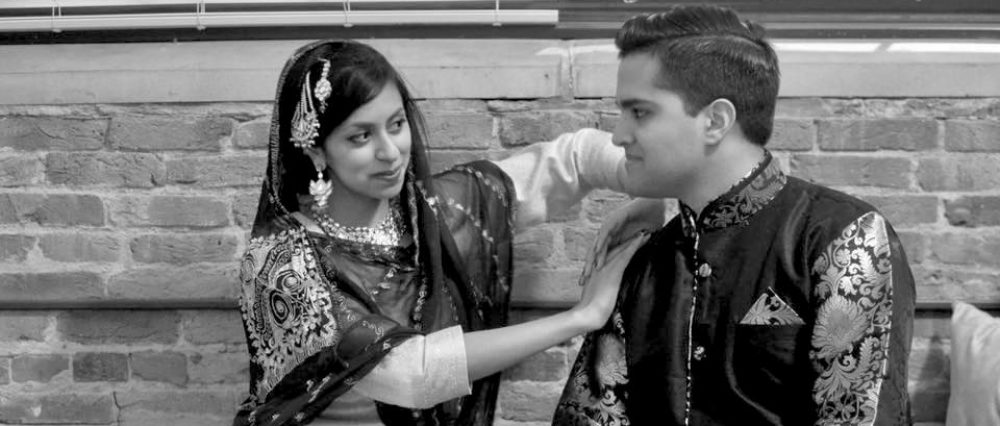
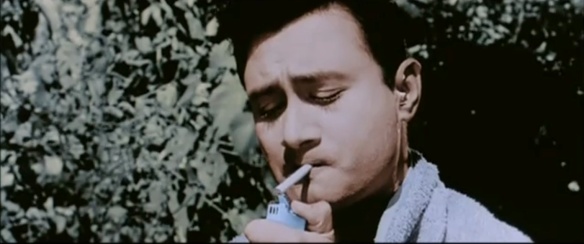
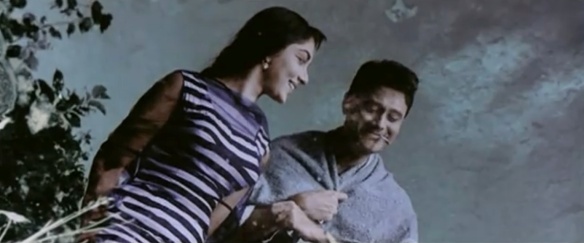
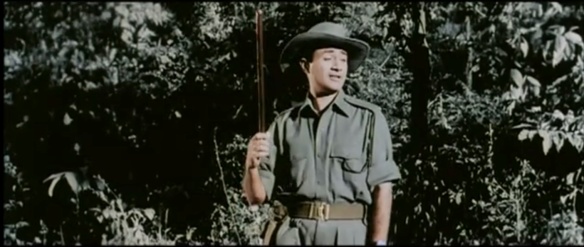
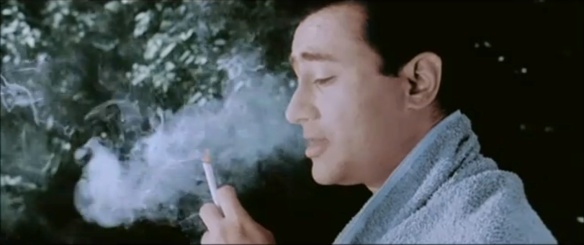
Hi there 🙂
Thanks for the post – v. informative !
But, don’t you think, changing a B&W movie into color actually Alters its depth & poignancy And the play on shadows that the director must’ve intended?
Can you imagine coloring up a Gurudutt film ?!
The colors are never true anyways, however much effort & patience & conscientiousness is put in; one can always spot that the movie/frame has been colored over.
Takes away all the magic & pristine simplicity yet cinematic complexity of B&W .
Just my thoughts…
Kudos on another extremely good post.
I agree completely! Colouring a Guru Dutt film would be blasphemy and I would probably organize a march on Film City to object. However, Guru Dutt films like Pyaasa and Kaaghaz Ke Phool were shot in a genius cinematographic style that embraced and enhanced black-and-white film stock. Arguably, a film like Mughal-e-Azam deserved to be shot completely in colour and would have attained greater glory because of it. However, due to budget restrains, only the song “Pyaar Kiya To Darna Kya” was shot in colour–and is one of the most magnificent scenes from the film.
A movie like Hum Dono walks the line. In black-and-white, the film remains sublime. The added colour does indeed often look like a paint job–but the fact that it was Dev Anand’s own intention leads me to believe that he was satisfied with the choice of colours and end product as he oversaw the work. But, yes, it’s complex and something of the magical simplicity of the original has indeed vanished–with a new take on the film in its place!
Hi there! Just stumbled across your blog on Google and it is just awesome! Awesomeeee! I giggled at Mr and Mrs ’55, because it’s a film. Good name choice, heehee. Oh, my name is Sasha, and I love old Hindi films. And I’m 13! I really admire the effort you put into these posts and such, and thank you so much for providing the translations! I can go without subtitles in a film, but sometimes I just don’t catch some words here and there, so, thanks again!
And yes, I really really really love Dev’s films (And him. :P) and I cheered out loud when I saw this post. Scared my cats a bit, but that’s alright. 😀
Thanks for the comments!! It’s wonderful that you’re a young person like us and have discovered the magic of old Bollywood cinema. Dev Anand has long been a personal favorite of ours and his films always challenged social norms of the day! Keep following and we’re glad you enjoyed 🙂
Yeah! 😀 Who else are your favorites? 😀 I like everyone actually, but I love Dev, Rajendra, Shammi, and Rajesh!
Pingback: Allah Tero Naam Lyrics and Translation: Let’s Learn Urdu-Hindi « Mr. & Mrs. 55 – Classic Bollywood Revisited!
the same chiming sound has now been used in dagabaaz re in dabangg 2 .. every time i listen to the new song , i cant stop thinking about the songs of hum dono
For all Dev Anand fans: There is a wonderful interview by Simi Garewal on her Rendevous show (available on utube and her website) with Dev Anand. The interview is so rich in meaning and filled with Dev’s unique outlook on life and film. At the end of the interview, he actually sings this song. Simply brilliant!
Thanks so much for this translation.
Pingback: Abhi Na Jao Chod Kar Lyrics and Translation: Let’s Learn Urdu-Hindi | Mr. & Mrs. 55 - Classic Bollywood Revisited!
dev in black (and waheeda) are superb…………seeing them in color is just not on
So thankful for this – and I’m going to join your facebook page. Every so often I put an old Bollywood song on – and remember my dear father who passed away 2 yeras ago. He used to sing old songs with his harmonium – Mohamed Rafi and Mukesh… and others . To get the translations into English is just such a gift. I always feel closer to him when i hear the beautiful songs. Those were good meaningful movies and songs. Thanks again!
Ver beautiful song and beautiful translation. I have posted it on my blog with a ping back link of your blog. Hope you won’t mind.
While viewing a video clip of Simi Grewal interviewing Dev Anand, ‘Main Zindagi Ka Saath Nibhata’ came up as a reference point of discussion. This in turn inspired me to look up your web site to ensure if you had translated this. To my great joy, yes you have an excellent translation of the entire song. My only comment is meaning of ‘shok’ as written to mean ‘to grieve’ in your summary. I listened to this song numerous times and to my ears sounds like ‘sog’ which in Punjabi or Urdu means mourning or grieving. I could not find any word ‘shok’ in the Urdu/English dictionary. This is beside the point, but I am most grateful to you for having this translation in your archives. It is quite an experience to listen to a gazel whose meanings are completely explained as you have been doing. Thank you again for providing us readers with very detailed explanations of very beautiful lyrics